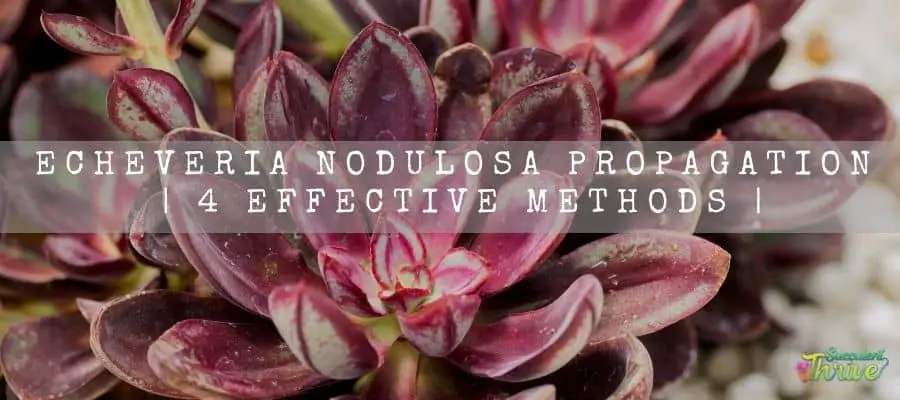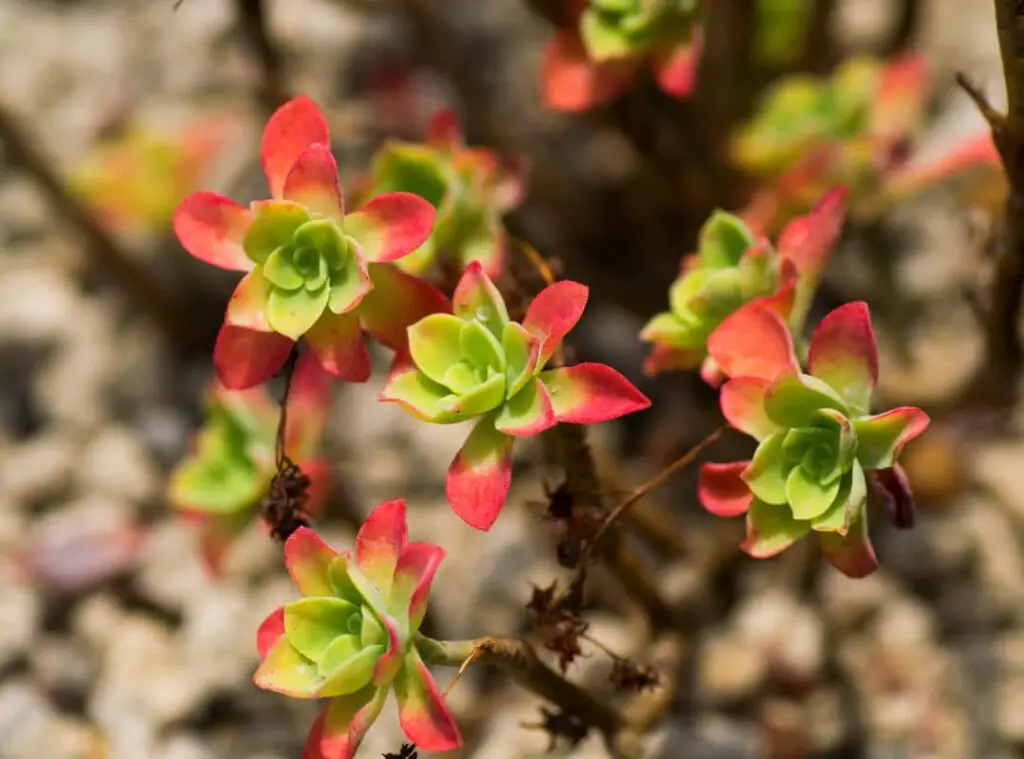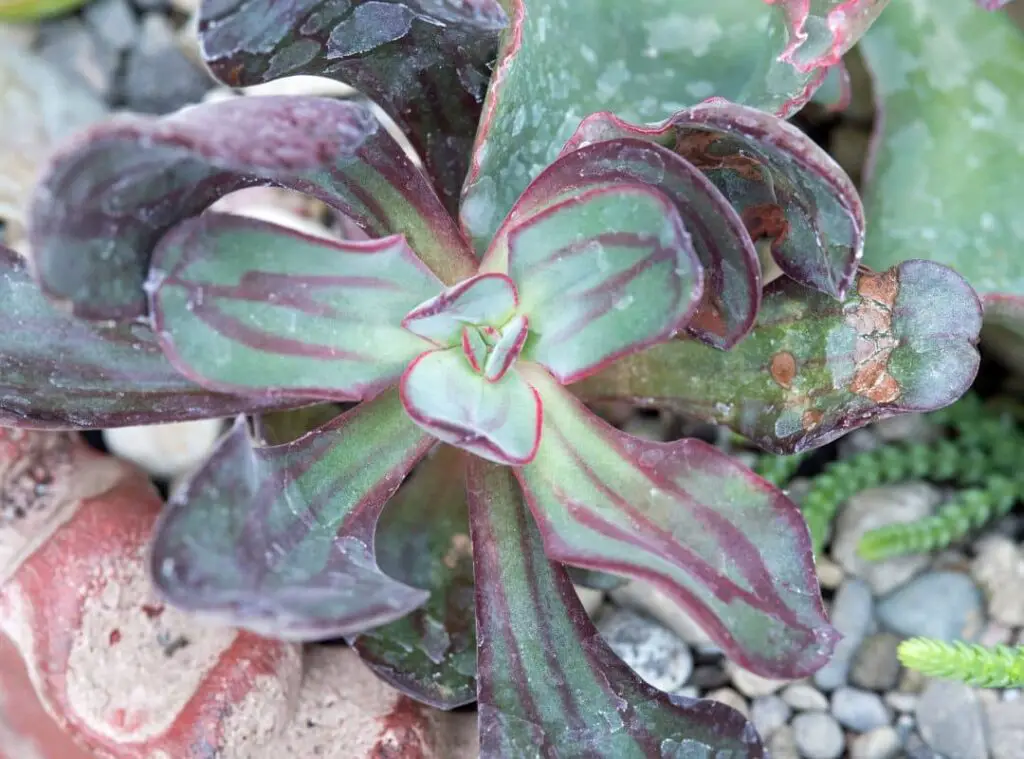You can conduct Echeveria nodulosa propagation by stem cuttings, leave cuttings, offsets or seeds. In this article I am going to give you a comprehensive guide to Echeveria nodulosa propagation.

Echeveria nodulosa are striking mind-blowing succulents which are commonly known as painted Echeverias. They are charming evergreen plants which would develop fleshy leaves. Further Echeveria nodulosa leaves would be more pointed and concave too.
You could spot them in olive green in color. Further , the red hues on the edges of the leaves add more grace to the whole look of the Echeveria nodulosa plants.
Not only that but also, Echeveria nodulosa produces yellowish attractive flowers along with pinkish margins in summer.
Can you propagate Echeveria nodulosa ?
There are several ways of propagating the Echeveria nodulosa plants. For example, you can use their stem cutting, leave cuttings and offsets to propagate them.
In addition to that, you could use the seeds propagation method to propagate the Echeveria nodulosa . That said it would consume a plenty of time and if you are a patient gardener you could try out this method.
Echeveria nodulosa propagation by stem cutting
First of all, you need to select a healthy stem cutting to use for the propagation. When you select a healthy stem cutting, you can utilize sharp tools such as clean knives or even garden shears to make the cuttings.
However, ensure that you are using all sterile tools to do this task. When you obtain the cutting, it has to have a few leaves right in the top part of the stem and none in the bottom part of the stems.
Once you obtain the cuttings, the next step would be to allow them wither and let them develop calluses.
When they developed calloused, you could plant the cuttings in a well-draining and a well aerated soil mix.
When you plant the cuttings, ensure that you don’t let any part of the leaf stay in contact with the soil. After that, locate the specimen in a spot where they can gain bright indirect sunlight. As the time goes, they would develop roots towards the soil.
Echeveria nodulosa propagation by leaf cutting
If you wish to practice the leaf propagation method, you need to first take off a leaf carefully from the mother plants.
You may either snip off the leaf or even just twist them off from the parent plant. If you wish to cut the leaf, you can use a clean knife or even scissors.
Ensure the leaf cuttings which you have used for this purpose are healthy and no part of the stem is remaining on that. Once you adhere to these tips, you can have successful results of the propagation process.
However, just like in the above stem cutting propagation method, you should allow the leaf cuttings to dry before you plant them in the soil mix.
Once you use dry lead cuttings for this purpose, it would ensure that there will not be any infection taking place in the specimen. Whenever the soil is dry, you need to consider watering them.

Do they produce seeds?
Echeveria nodulosa produces seeds and you may even make use of them to propagate them as well. However, the seed propagation method is somewhat time consuming.
Do they produce offsets?
Echeveria nodulosa produces plenty of offset around the plants. so, if you wish to use them for propagation, all you have to do is just pull them off and keep them aside for a couple of days until they develop calluses.
Once the offsets have developed callouses, you can grow them in an appropriate soil mix and the roots would tend to grow towards the soil while the offset would stay right on the top of the soil.
If you spot the specimen is dry, you can either mist them or water them lightly using a spray bottle.
Can you root the Echeveria nodulosa in water?
You may use Echeveria nodulosa stem cuttings and propagate them in water. The only difference here would be the change in the growth medium.
So, to start off you need to first obtain the cuttings using all sterile and clean tools as described in the soil propagation methods.
You need to obtain cuttings which are about 2-4 inches in size. Furthermore, ensure the cuttings have at least one or two leaves.
When you make the cutting you should cut it off slightly below the node. Then, leave the cuttings in an empty tray and expose them for bright indirect sunlight for about two to three days.
After that you need to choose a vessel to conduct the propagation. Ideally a glass jar or any other clear jar would work well for this process.
That way you could observe well what is happening in the specimen and further it would be helpful for the cuttings to gain ample sunlight as well.
When the cuttings have developed the callouses, you could fill the jar with water. After that place the cuttings in the jar whilst ensuring the edges of the cuttings are slightly above the surface of the water layer.
Once you complete all these steps you may place the specimen in a spot whether they can gain bright indirect sunlight.
Keep in mind to check the water level on a constant basis. It would usually take about 2-6 weeks to develop the roots.
That said it would vary depending on the climate. The advantage of using the water propagation method is that it is less messy when compared to the soil propagation method.

How to treat after propagation
Echeveria nodulosa Light requirement
Echeveria nodulosa would flourish if you expose them to morning full sunlight and partial shade during the hottest hours of the day.
In simple words, moderate sunlight would work well with them. If you expose the Echeveria nodulosa plants under direct sunlight available during the hottest hours of the day, it will result in the scorches in the plants.
So, ideally if you wish to cultivate them indoors, I recommend you place them near a bright lit place.
On the other hand, when you plant them outdoors, you need to choose a place where they can again have ample sunlight in the morning and partial sunlight during the afternoon hours.
Echeveria nodulosa Soil requirement
A good drainage is a crucial factor for Echeveria nodulosa plants just like the fellow succulents and cactus in general.
Once you go ahead with a well-draining soil mix, it would ensure that your precious plants don’t go through rot.
In addition to that, your selected soil mix needs to have a good aeration as well. Ideally a succulent soil mix which consists of 50% – 70 % mineral grit would be optimal for these plants.
Mineral grit could be such as pumice , coarse sand, perlite etc. Besides all these factors I suggest you use a pot which has ample drainage as well. Lastly , it would be better if you could use a planter which is made out of a porous material too.
Echeveria nodulosa Watering requirement
Watering the Echeveria nodulosa plants properly is a critical factor when you look after them after propagation.
In simple terms, Echeveria nodulosa have typical requirements in terms of water just like the rest of other succulents.
Do not ever leave them exposed for waterlogged, damp and soggy conditions. You should always avoid watering them in excess. Ideally you need to water them thoroughly and let them dry after that.
Before you water them, always ascertain whether it is dry from the previous watering session. If you are hesitant whether you need to water the plants or not, best is to always wait for a couple of days and then apply water.
Echeveria nodulosa temperature and humidity requirement
Echeveria nodulosa would opt to grow in an optimal temperature around 65 degrees – 72 degrees Fahrenheit.
Literally the exposure for colder temperatures would not help the plants to grow vigorously. If you ever come across any situation where you witness the plants are suffering from getting exposed to colder conditions, you need to immediately shift them indoors.
Echeveria nodulosa plants cannot withstand temperatures below 50 degrees Fahrenheit. In terms of the humidity aspect of the Echeveria nodulosa plants, I would say the best would be to expose them to a humidity level of 50 %.
Echeveria nodulosa fertilizer requirement
Echeveria nodulosa does not have a massive demand when it comes to fertilizers. However, it would be better if you could feed them with a balanced diluted liquid fertilizer when they are at their actively growing pace.
You may apply it once every fortnight. You may either put it into a container and then apply or just apply them directly into the soil.
However, ensure that you dilute it and then apply to the plants as unless it would result in feed burns of the plants.
To be more precise, you need to add one teaspoon of fertilizer per quarter of water. I suggest you water the plants right after you feed them.
The purpose of doing this step is to wash off any remaining surplus which is remaining in the soil.
Conclusion
Echeveria nodulosa are hardy and versatile plants which would grow well as long as you provide the basic growing conditions right.
So, how wonderful would it be to propagate them and make new plants and share them among your friends.
As such , trust now that you are all set and confident to propagate them and you are well aware of the after care tips of the propagation as well.
Read Next : Peperomia Ferreyrae Propagation, 4 Effective Methods
